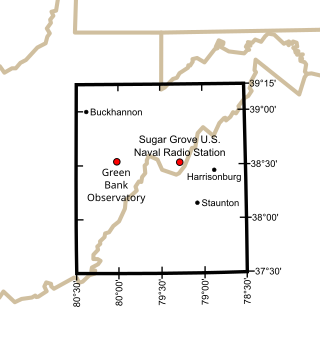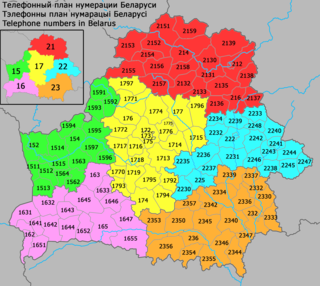
A telephone switchboard was a device used to connect circuits of telephones to establish telephone calls between users or other switchboards, throughout the 20th century. The switchboard was an essential component of a manual telephone exchange, and was operated by switchboard operators who used electrical cords or switches to establish the connections.

Local access and transport area (LATA) is a term used in U.S. telecommunications regulation. It represents a geographical area of the United States under the terms of the Modification of Final Judgment (MFJ) entered by the United States District Court for the District of Columbia in Civil Action number 82-0192 or any other geographic area designated as a LATA in the National Exchange Carrier Association, Inc. Tariff FCC No. 4. that precipitated the breakup of the original AT&T into the "Baby Bells" or created since that time for wireline regulation.
Wide Area Telephone Service (WATS) was a flat-rate long-distance service for customer dial-type telecommunications in the service areas of the North American Numbering Plan (NANP).
Local exchange carrier (LEC) is a regulatory term in telecommunications for the local telephone company.
An interexchange carrier (IXC), in U.S. legal and regulatory terminology, is a type of telecommunication company, commonly called a long-distance telephone company. It is defined as any carrier that provides services across multiple local access and transport areas (interLATA). Calls made on telephone circuits within the local geographic area covered by one local network are handled only by that intraLATA carrier, commonly called a local telephone exchange carrier. Local calls are usually defined by connections made without additional charge whether the connected call is in the same LATA or connects to another LATA with no charge. IntraLATA usually refers to rated or toll calls between LATA within state boundaries, as opposed to interstate, or calls between LATAs in different states.

The North American Numbering Plan (NANP) is a telephone numbering plan for twenty-five regions in twenty countries, primarily in North America and the Caribbean. This group is historically known as World Zone 1 and has the telephone country code 1. Some North American countries, most notably Mexico, do not participate with the NANP.
4-1-1 is a telephone number for local directory assistance in Canada and the United States. Until the early 1980s, 4-1-1 — and the related 1-1-3 number — were free to call in most states.
A toll-free telephone number or freephone number is a telephone number that is billed for all arriving calls. For the calling party, a call to a toll-free number from a landline is free of charge. A toll-free number is identified by a dialing prefix similar to an area code. The specific service access varies by country.
In telecommunications, directory assistance or directory inquiries is a phone service used to find out a specific telephone number and/or address of a residence, business, or government entity.

The National Radio Quiet Zone (NRQZ) is a large area of land in the United States designated as a radio quiet zone, in which radio transmissions are restricted by law to facilitate scientific research and the gathering of military intelligence. About half of the zone is located in the Blue Ridge Mountains of west-central Virginia while the other half is in the Allegheny Mountains of east-central West Virginia; a small part of the zone is in the southernmost tip of the Maryland panhandle.
A telephone numbering plan is a type of numbering scheme used in telecommunication to assign telephone numbers to subscriber telephones or other telephony endpoints. Telephone numbers are the addresses of participants in a telephone network, reachable by a system of destination code routing. Telephone numbering plans are defined in each of the administrative regions of the public switched telephone network (PSTN) and in private telephone networks.
In telecommunications, a long-distance call (U.S.) or trunk call is a telephone call made to a location outside a defined local calling area. Long-distance calls are typically charged a higher billing rate than local calls. The term is not necessarily synonymous with placing calls to another telephone area code.

Telephone numbers in Singapore, also known as the National Numbering Plan, are regulated by the Info-communications Media Development Authority (IMDA). Due to the small geographical size of Singapore, there are no area or trunk codes; all numbers belong to one numbering area, and thus come in the same 8-digit format. Numbers are categorised based on the first digit, thus providing ten possible categories, of which six are currently in use and the remaining four reserved for future usage.

The dialling plan for mobile networks and new landline operators is closed; all subscriber numbers must be dialled in full. For landline numbers starting with 02, the dialling plan used to be open; the trunk digit and area code could be omitted if the caller was in the same area code as the callee. However, starting May 3, 2008, all landline numbers must be dialled in full.

This is a discussion of telephone numbers in Ukraine. The nation of Ukraine has country code +380. It switched to the European Union's common dialing plan in 2009. Thus, Ukrainian phone numbers consist of a 2-digit zone code, an optional subzone code, an optional filler, and the local phone number. However, following the 2022 Russian invasion of Ukraine, the regions of Crimea, Donetsk, and Luhansk were given Russian telephone codes instead, as if they were following telephone numbers in Russia.

Belarus began using its own country code +375 in 1995, replacing the +7 international country code inherited from the Soviet Union. The local numbering plan was inherited from the Soviet Union and remains with few changes.
Toll-free telephone numbers in the North American Numbering Plan have the area code prefix 800, 833, 844, 855, 866, 877, and 888. Additionally, area codes 822, 880 through 887, and 889 are reserved for toll-free use in the future. 811 is excluded because it is a special dialing code in the group NXX for various other purposes.

PSTN network topology is the switching network topology of a telephone network connected to the public switched telephone network (PSTN).
In conventional landline telephony, a non-dialable toll point or toll station was a lone station or line serving a rural subscriber many miles from the nearest central office. As it had no home telephone exchange and therefore no local calling area, no customer could dial its number; all connections to it had to be obtained manually by the long distance operator.
In the North American Numbering Plan, a rate center is a geographically-specified area used for determining mileage and/or usage dependent rates in the public switched telephone network.








